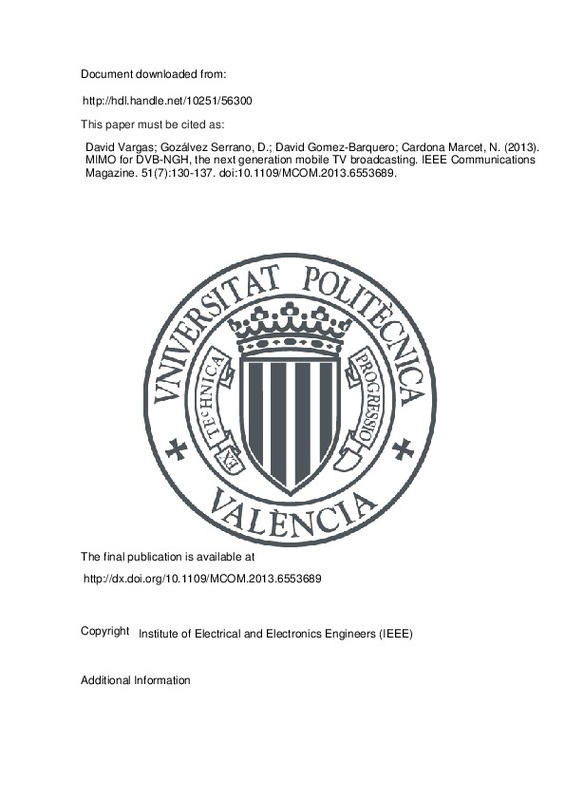JavaScript is disabled for your browser. Some features of this site may not work without it.
Buscar en RiuNet
Listar
Mi cuenta
Estadísticas
Ayuda RiuNet
Admin. UPV
MIMO for DVB-NGH, the next generation mobile TV broadcasting
Mostrar el registro sencillo del ítem
Ficheros en el ítem
| dc.contributor.author | Vargas Paredero, David Eduardo
|
es_ES |
| dc.contributor.author | Gozálvez Serrano, David
|
es_ES |
| dc.contributor.author | Gómez Barquero, David
|
es_ES |
| dc.contributor.author | Cardona Marcet, Narciso
|
es_ES |
| dc.date.accessioned | 2015-10-21T11:55:41Z | |
| dc.date.available | 2015-10-21T11:55:41Z | |
| dc.date.issued | 2013-07 | |
| dc.identifier.issn | 0163-6804 | |
| dc.identifier.uri | http://hdl.handle.net/10251/56300 | |
| dc.description.abstract | DVB-NGH (Digital Video Broadcasting - Next Generation Handheld) is the next generation technology for mobile TV broadcasting, which has been developed by the DVB project with the most advanced transmission technologies. DVB-NGH is the first broadcasting standard to incorporate multiple-input multiple-output (MIMO) as the key technology to overcome the Shannon limit of single antenna communications. MIMO techniques can be used to improve the robustness of the transmitted signal by exploiting the spatial diversity of the MIMO channel, but also to achieve increased data rates through spatial multiplexing. This article describes the benefits of MIMO that motivated its incorporation in DVB-NGH, reviews the MIMO schemes adopted, and discusses some aspects related to the deployment of MIMO networks in DVB-NGH. The article also provides a feature comparison with the multi-antenna techniques for 3GGP's LTE/LTE-Advanced for cellular networks. Finally, physical layer simulation results calibrated within the DVB-NGH standardization process are provided to illustrate the gain of MIMO for the next generation of mobile TV broadcasting. | es_ES |
| dc.language | Inglés | es_ES |
| dc.publisher | Institute of Electrical and Electronics Engineers (IEEE) | es_ES |
| dc.relation.ispartof | IEEE Communications Magazine | es_ES |
| dc.rights | Reserva de todos los derechos | es_ES |
| dc.subject | MIMO | es_ES |
| dc.subject | Mobile TV | es_ES |
| dc.subject | Digital video broadcasting | es_ES |
| dc.subject | Long Term Evolution (LTE) | es_ES |
| dc.subject | Multiplexing | es_ES |
| dc.subject | Transmitting antennas | es_ES |
| dc.subject.classification | TEORIA DE LA SEÑAL Y COMUNICACIONES | es_ES |
| dc.title | MIMO for DVB-NGH, the next generation mobile TV broadcasting | es_ES |
| dc.type | Artículo | es_ES |
| dc.identifier.doi | 10.1109/MCOM.2013.6553689 | |
| dc.rights.accessRights | Abierto | es_ES |
| dc.contributor.affiliation | Universitat Politècnica de València. Instituto Universitario de Telecomunicación y Aplicaciones Multimedia - Institut Universitari de Telecomunicacions i Aplicacions Multimèdia | es_ES |
| dc.contributor.affiliation | Universitat Politècnica de València. Departamento de Comunicaciones - Departament de Comunicacions | es_ES |
| dc.description.bibliographicCitation | Vargas Paredero, DE.; Gozálvez Serrano, D.; Gómez Barquero, D.; Cardona Marcet, N. (2013). MIMO for DVB-NGH, the next generation mobile TV broadcasting. IEEE Communications Magazine. 51(7):130-137. doi:10.1109/MCOM.2013.6553689 | es_ES |
| dc.description.accrualMethod | S | es_ES |
| dc.relation.publisherversion | http://dx.doi.org/10.1109/MCOM.2013.6553689 | es_ES |
| dc.description.upvformatpinicio | 130 | es_ES |
| dc.description.upvformatpfin | 137 | es_ES |
| dc.type.version | info:eu-repo/semantics/publishedVersion | es_ES |
| dc.description.volume | 51 | es_ES |
| dc.description.issue | 7 | es_ES |
| dc.relation.senia | 257791 | es_ES |







![[Cerrado]](/themes/UPV/images/candado.png)

